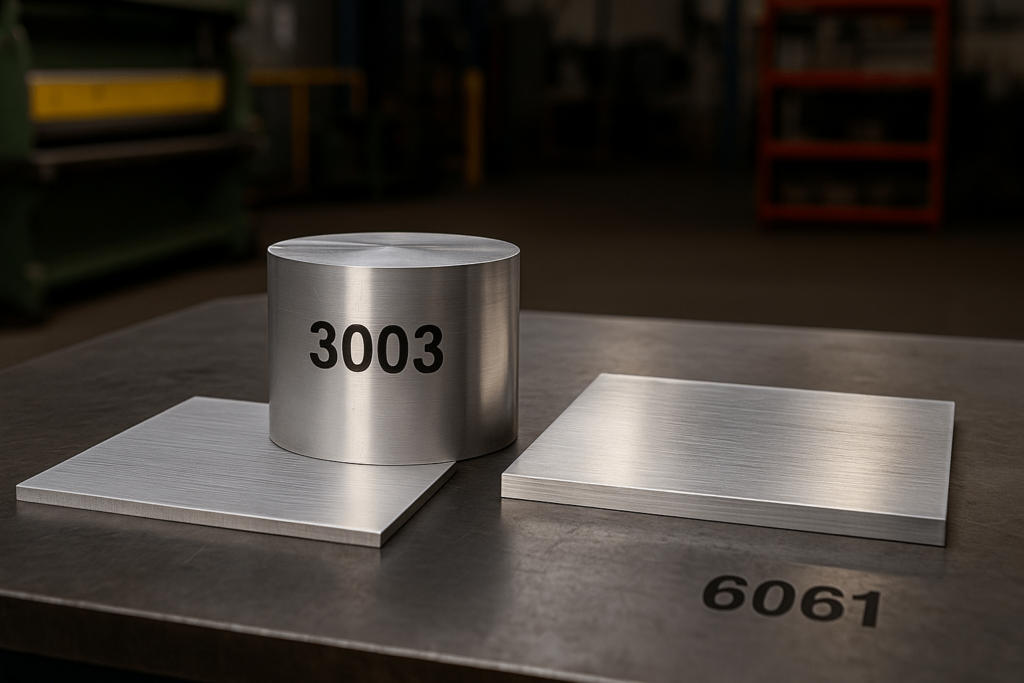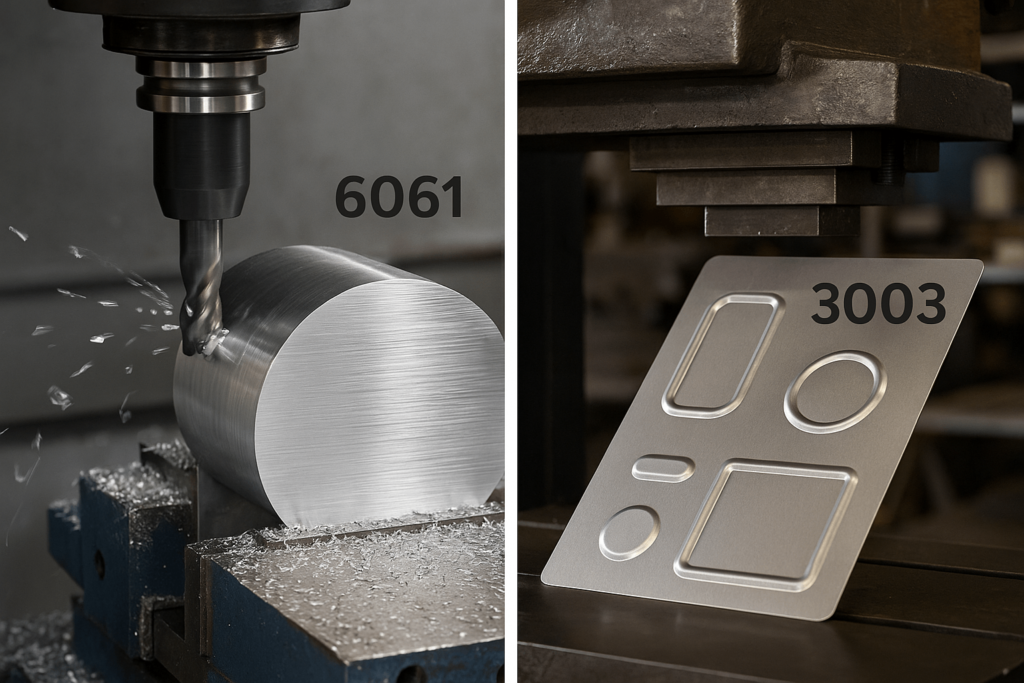Why Material Choice Directly Affects Procurement Success
For global procurement teams sourcing aluminum at scale, choosing between 3003 and 6061 isn’t just about datasheet comparisons—it’s about selecting the right alloy for production efficiency, downstream process compatibility, and overall supply chain control.
Both alloys are popular in industrial fabrication, yet serve distinct functions. Misapplying one for the other can result in scrap losses, longer production cycles, or quality compliance failures.
A real-world example: a Southeast Asian HVAC supplier ordered 60,000 units of CNC-bent panels using 6061-T6. Although structurally strong, the alloy cracked during forming. Switching to 3003 dropped the rejection rate by 35% and extended tooling life by 20%, improving both yield and delivery reliability.
This guide helps you evaluate both alloys based on sourcing priorities—not just theoretical specs—and is intended as a detailed aluminum alloy selection guide for bulk metal sourcing.
Material Fundamentals: Core Differences That Matter in Bulk Manufacturing
3003 is a non-heat-treatable aluminum alloy alloyed with manganese. It is highly formable, corrosion-resistant, and ideal for bending, spinning, and stamping operations—making it one of the best aluminum alloys for forming operations.
6061 is a heat-treatable alloy with magnesium and silicon. It delivers higher tensile strength and is preferred for precision machining, structural strength, and high-load performance. In bulk aluminum supply contracts, this alloy is often requested for parts requiring high machinability.
Key Composition Comparison
| Alloy | Heat Treatable | Main Alloying Elements | Formability | Strength |
|---|---|---|---|---|
| 3003 | No | Manganese | High | Moderate |
| 6061 | Yes (T6) | Magnesium, Silicon | Moderate | High |
These differences impact not only forming but also surface treatment response, weldability, and product durability—factors every sourcing team must consider when choosing aluminum for manufacturing.

Mechanical Properties for Production Planning
| Property | 3003-H14 | 6061-T6 |
| Ultimate Tensile Strength | ~200 MPa | ~290 MPa |
| Yield Strength | ~145 MPa | ~240 MPa |
| Elongation at Break | ~10% | ~12% |
| Brinell Hardness | 40 | 95 |
| Elastic Modulus | 70 GPa | 68.9 GPa |
6061 is clearly stronger and more rigid—an advantage in aerospace components, structural profiles, and load-bearing enclosures. Meanwhile, 3003 offers better workability for rolled panels, curved casings, and lightweight protective shells.
If your product requires heavy forming or deep drawing, 3003 minimizes cracking and lowers tool wear. For machined precision parts, 6061 is far more time- and cost-efficient, especially in CNC aluminum machining operations.

Processing Considerations: Matching Alloy to Manufacturing Environment
Forming
3003 bends, punches, and spins with ease. For high-speed press lines, it reduces tool maintenance and allows for tight design tolerances. 6061 is harder and may require annealing before forming, especially in T6 temper. This makes 3003 a more viable aluminum alloy for stamping and bending.
Machining
6061 shines in CNC environments. It provides clean chip formation and faster cut speeds, ideal for tight tolerance aluminum parts. 3003 is softer and may gum up tools, increasing setup time and tool change frequency.
Welding
Both alloys are weldable. 3003 is commonly used for seam welding thin sheets. 6061 requires more control but yields stronger joints post-heat-treatment—important when sourcing aluminum for welded assemblies.
Surface Finish
6061 delivers superior results for anodizing and decorative coating. It maintains finish consistency and resists oxidation. 3003 is often painted or powder coated but may not anodize evenly, so it’s less suitable for powder coating vs anodizing comparisons where decorative finish is critical.

Cost vs Output Efficiency: What Bulk Buyers Should Weigh
Don’t judge an alloy by price per kilo alone. Smart buyers measure total cost per finished unit—particularly when engaging in OEM aluminum part selection.
| Cost Factor | 3003 | 6061 |
| Material Price | Lower | Higher |
| Scrap Rate (Forming) | Low | Medium to High |
| Tool Wear Impact | Lower | Higher |
| Machining Time | Slower | Faster |
| Surface Finish Options | Powder coat, paint | Anodizing, powder coat |
For long-run production, 3003 lowers tooling costs and rejects. 6061 lowers machining cost and improves structural confidence. The ideal choice depends on your production flow, not just the end product or price of aluminum per kg.
Application Relevance: Aligning Alloy with Use Case
When 3003 Is the Right Fit
Ducting, Roofing, Cladding: Formability, corrosion resistance
Storage Tanks, Food Equipment: Non-toxic, easy to clean and shape; common in food-grade aluminum products
Panels for Cabinets, Electrical Boxes: Easy to fabricate and paint; often used in forming aluminum sheet metal
When 6061 Adds Value
Machined Enclosures, Brackets: High strength and dimensional precision; ideal for structural aluminum parts
Aerospace and Transport: Lightweight with high rigidity
Architectural Frames, Supports: Strong, aesthetically finished, often anodized
Avoid overengineering. If your product doesn’t need structural strength or anodized aesthetics, 6061 may be excessive. If precision and strength are key, 3003 might not meet spec.
Quick Decision Matrix for Buyers
| Requirement Category | Preferred Alloy |
| High-Speed Forming | 3003 |
| Tight Tolerance Machining | 6061 |
| Decorative Anodized Finish | 6061 |
| Large Volume Cost Control | 3003 |
| Structural Load Requirements | 6061 |
This matrix can be used during internal reviews, RFQs, or supplier evaluations to avoid mismatches in bulk aluminum orders.
Mistakes to Avoid in Alloy Sourcing
Relying Solely on Strength Data: Higher strength doesn’t always mean better value. Many low-stress components don’t need the over-specification of 6061.
Skipping Finish Requirements: If anodizing is part of your process, 3003 may cause adhesion and color inconsistency issues. This is a key consideration in aluminum for powder coating vs anodizing.
Ignoring Equipment Fit: If your forming equipment is tuned for softer materials, 6061 will increase reject rates and wear costs.
Each alloy’s downstream behavior affects cost, yield, and customer satisfaction—especially for high-volume aluminum sourcing projects.
Final Takeaway: Smart Alloy Choices Drive Better Projects
In the world of metal procurement, the best decisions aren’t about the most popular material—they’re about alignment between product design, factory capability, and logistics.
3003 offers an excellent balance of price and formability. 6061 brings superior machinability and structural performance. Choosing the right one early prevents production delays and unexpected costs later.
YISHANG supports global procurement teams with technical consultation, material optimization, and fabrication support for aluminum sourcing at scale.
👉 Ready to match the right alloy to your production process? Contact YISHANG for tailored advice.

